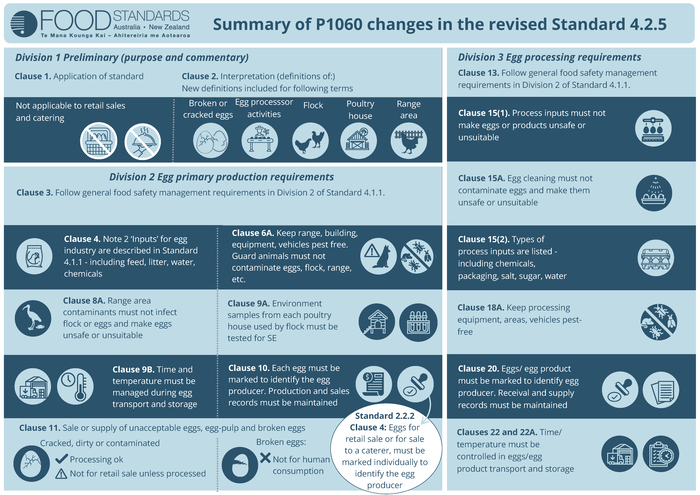What’s changing?
Standards 4.2.5 and 2.2.2 of the Code will be updated. Key changes include:
- Environmental monitoring of poultry houses: New requirements will support early detection of SE on farms.
- Stronger egg traceability measures: Improved traceability will make it easier to identify the source of contaminated eggs during foodborne illness investigations, reducing the likelihood of widespread illness and costly recalls.
- Temperature requirements for storage and transport: New requirements will help minimise the risk of Salmonella growth during distribution.
- Pest control and range area management: New measures will help reduce the likelihood of flock and egg contamination from pests and range areas.
What’s not changing?
Refrigeration across the supply chain: Mandated refrigeration of eggs throughout the supply chain has not been introduced at this stage. This reflects the sporadic nature of SE in Australia and the high costs of refrigerated storage. We may review this in the future if the situation changes.
Why this matters?
- Eggs are a major source of Salmonella: From 2015 - 2019 eggs were the suspected source in around 40% of foodborne Salmonella outbreaks in Australia.
- Targeted on-farm controls help reduce transmission: SE can contaminate eggs internally as they are formed in the hen. Monitoring and controls can reduce this risk.
- Lower public health and economic impacts: Salmonella related foodborne illness costs the Australian healthcare system an estimated $140 million each year.
- Stronger protections across the supply chain: The changes aim to improve food safety, reduce illness, and maintain consumer and market confidence.
At a glance: See what’s changing
View the infographic with a summary of P1060 changes in the revised Standard 4.2.5 (PDF 650 KB)
Consultation and assessment
The proposal was assessed under our general procedure and included public consultation in March 2025. Feedback from this consultation, along with our scientific assessment and engagement with stakeholders, informed our final decision.
Read our full assessment and the approved changes:
Approval
- Approval Report (898KB)
- Supporting document 1 - Risk Assessment (at Approval) (2.28MB)
- Supporting document 2 - Quantitative model (6210KB)
- Supporting document 3 - Current food safety measures (1MB)
- Supporting document 4 - Decision Regulatory Impact Statement (725KB)
- Supporting document 5 - Overview of egg industry in Australia (350KB)
- Supporting document 6 - Consumer Literature Review (840KB)
- Supporting document 7 - Guidance plan for compliance with Standard 4.2.5 (567KB)
Call for submissions
- Call for submissions (PDF 614KB)
- Supporting document 1 - risk assessment (PDF 3.8MB)
- Supporting document 2 - quantitative model (PDF 540KB)
- Supporting document 3 - current food safety measures (PDF 931KB)
- Supporting document 4 - consideration of costs and benefits (PDF 495KB)
- Supporting document 5 - overview of egg industry in Australia (PDF 317KB)
- Supporting document 6 - consumer literature review (PDF 778KB)
- Supporting document 7 - guidance plan for compliance with Standards 4_2_5 (PDF 538KB)
Click here to view submissions from the consultation.
Administrative assessment
- Administrative assessment report (238KB)

